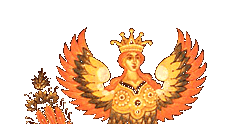Ivan Bilibin (1876-1942) was a Russian artist, born in St. Petersburg, somewhat isolated from the associations with traditional Russian art found so strongly among the art community in Moscow. His first inspirations came from Russian folk and fairy tales. After seeing an exhibition by Victor Vasnetsov in 1899 which included images and scenes from folk lore and opera, he was drawn to the remoteness of the wildernesses of Old Russia that gave rise to the legends. His watercolors from this trip were seen and admired by the "Department for the Production of State Documents" and he was commissioned to illustrate a series of books of fairy tales.
These books, including The Tale of Ivan the Tsar's Son, The Firebird and the Grey Wolf, The Frog Princess, The Feather of Finist the Falcon, Maria Morevna, The Little White Duck, and Vassilisa the Beautiful, propelled the young Bilibin headlong into a career of illustration, set and costume design, teaching and mural painting.
Bilibin's approach to these tales was guided by a strong sense of place. The forests and mountains of Old Russia were predominant players in images that often provided as many distractions as focal points. He seemed anxious to incorporate traditional designs and motifs, often as framing devices for illustrations that didn't require them. Yet his solid depiction of the terrain and costumes made his work recognizable and appealing, despite his youthful miscues. And, most importantly, his ability to bring a sense of reality to a world of ghosts and glowing skulls reinforced the notion that these stories might really have happened and certainly heightened their appeal.
These books, with their identical covers, were still in print as recently as 1976 (now why doesn't that sound so recent anymore?) and are oft-requested items. The titles in the center of the cover were the only modifications to a common design that was easily recognizable. The interior drawings showed his increasing skills as both an artist and a storyteller. These images from Vassilisa the Beautiful are some of his earliest work from 1899. They're remarkably mature for a 24-year-old and hint at the Art Nouveau influences he relished.
By 1902, in The Little White Duck, these influences were incorporated into the borders and the foliage of the image as seen in the image at right.
During and after the fairy tale series, Bilibin worked a lot in pen and ink for magazines, book covers, and The Tale of the Golden Cockerel a reprise of the folk story in a combination of pen, ink and watercolor (see below). Several other folk and fairy tale projects were begun over the coming years. He never really escaped from his early reputation. He considered the mixture of fantasy, folk lore and historical and geographical authenticity to be his milieu and seldom ventured very far from it.
His style became more formal and he applied his vision to the sets and costumes of a series of operas, including The Golden Cockerel (1909), Askold's Grave (1912), Ruslan and Ludmila (1913), Sadko (1913,14) and others. His reputation as a fantasist and his association with Old Russian imagery served him well in this new career, as did his many visits to the Crimea where he found continued inspiration and flavor for his art.
He left Russia in 1920 for Egypt, where he set up a studio and lived until 1925. He moved to Paris for the opening of the World Exhibition. He had a one man show in Prague in 1926 and helped stage an exhibition of Russian artists in Paris in 1927. He was, by now, an accomplished and sought-after stage designer and helped stage numerous ballets and operas in Paris, which had its own "Russian Opera Season." Finally in 1931 he returned to the illustration of Russian and Oriental fairy tales for a Parisian publisher. At left is an image from Father Frost (1932) and at right is one from The Lay of Tsar Ivan Vassilyevich, His Young Oprichnik and the Stouthearted Merchant Kasashnikov from 1938.
He returned to Russia in 1936 where he died in February of 1942. He was in Leningrad during the German blockade. He left several unfinished projects, many of which can be partially seen in Sergei Golynets' Ivan Bilibin co-published by Aurora and Abrams in 1982. One project was the illustrations for The Tale of the Capital City of Kiev and of the Russian Bogatyrs that he was working on during the last few years of his life. As can be seen at right, his design strengths were still present and the trademark historically accurate accoutrements were everywhere.
It's worth looking up now and again from our, dare I say it again, provincial, boundaries to examine the whole world of illustration. Though Bilibin's work was not widely available in America until the 1976 reprints by Goznak, it was received with respect and appreciation. Golynets' book about him gave us even more to enjoy and to marvel at. Today he's an artist with a growing following.
http://www.bpib.com/illustrat/bilibin.htm
|



